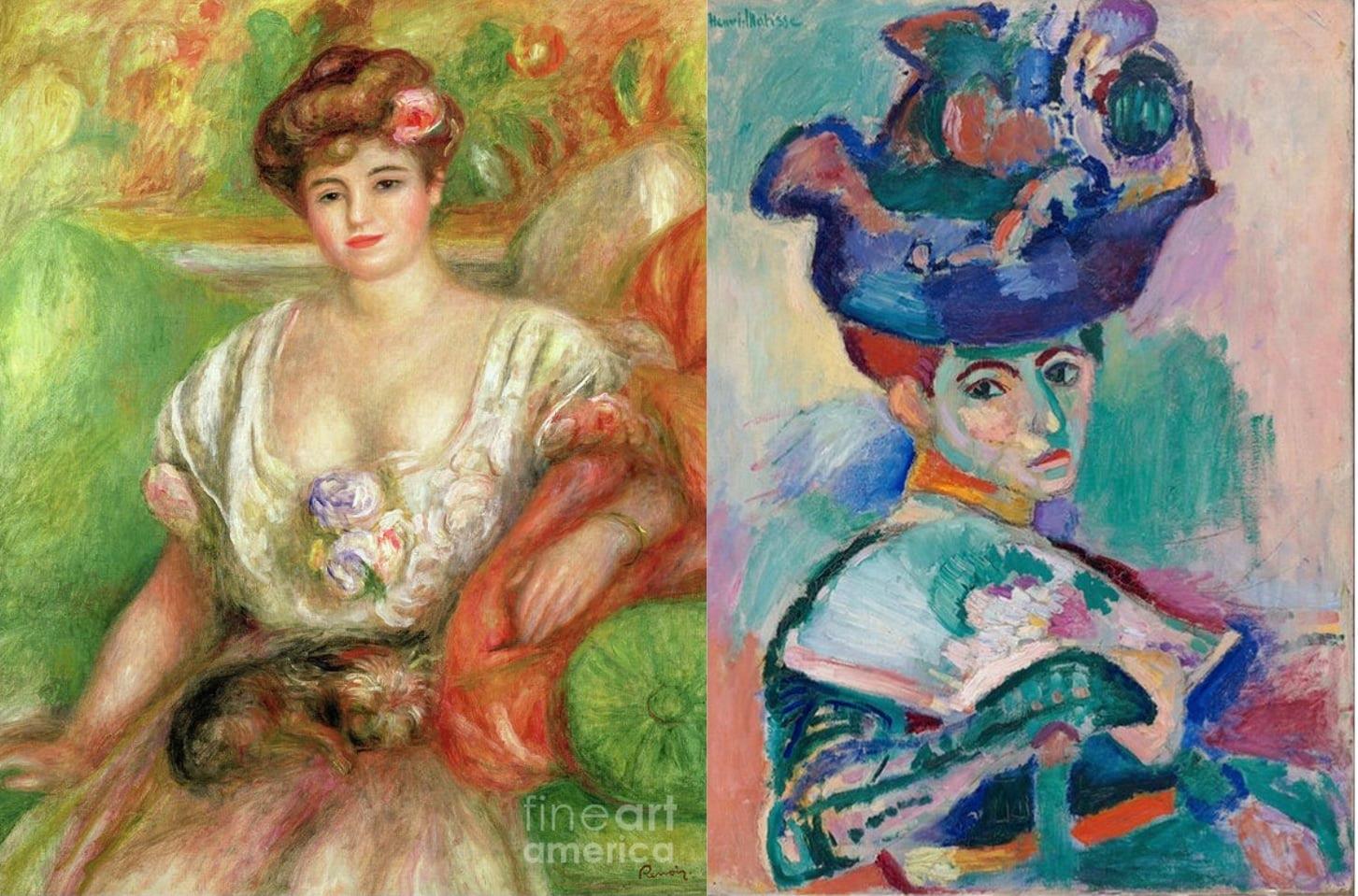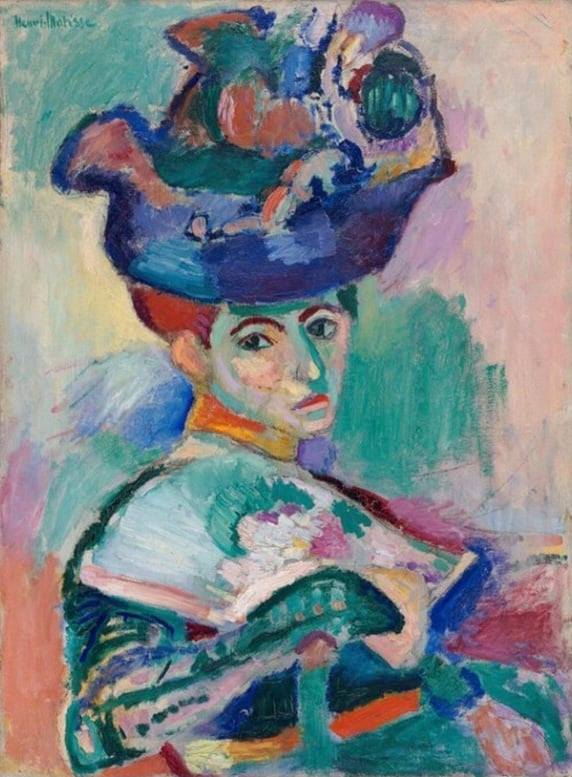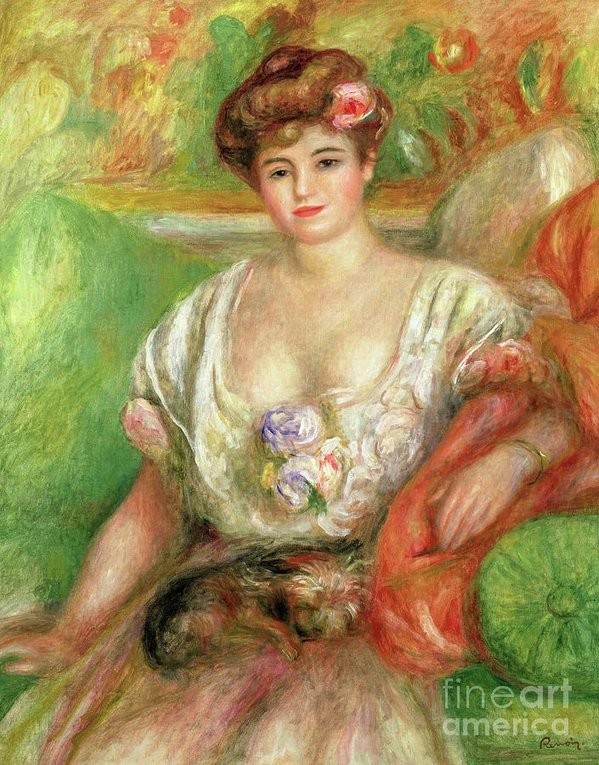A Comparison between Pierre Augusta Renoir’s ‘Misia Sert with a lap dog’ from the Impressionist period, circa 1906, oil on canvas, Barnes Foundation, Philadelphia U.S.A and Henri Matisse’s ‘La Femme au Chapeau’ or ‘Woman with a Hat’ from the Fauvism period circa 1905, oil on canvas, San Francisco Museum of Art
Pierre Auguste Renoir’s famous portrait of Misia Sert, muse and patron to artists, “ Misia Sert with a lapdog”, is done in a style that is a combination of Impressionism and his older classic style of painting. By early 1888, Renoir, a French artist with an Impressionist style had evolved to a new direction and there was a fresh emphasis on color and sensuality in his paintings, soft and light of touch, something very evident in this portrait. The other portrait, “La Femme au Chapeau” or “Woman with a Hat” made by Henri Matisse in the Fauvism style, in 1905 of his wife, Amelie Parayre, however, used color like the art world had never seen before. He used free and expressive color in a non-naturalistic way that created an emotional response in the viewer. Though both the artists had a strong use of color, the treatment of their subjects was very different. Whereas Renoir’s portrait renders shadows and highlights in strong, pure color – vibrancy created by light and shadow, Matisse’s work creates more of a luminosity that comes from within the painting with the use of his colors. … Bright blues, greens, oranges, yellows, and reds used to depict the face. It reflected a vibrancy created by vivid, explosive, and high-energy colors.
In Renoir’s portrait, we see the use of broken brushstrokes, wherein different strokes are loosely blended to create visual harmony. On the other hand, Matisse uses thick dabs of color and broad, directional strokes that somehow come together when viewing the portrait, as one. Even the background in Renoir’s painting has smooth edges and you see the figure softly fusing into the surroundings. In contrast, Matisse’s figure has sharp, well-defined outlines that assert their own individuality from the background. Whereas Renoir’s portrait is a realistic depiction of the subject, Matisse’s relationship between tones and actual views is abstract. One can also see the progression of thought through fashion between the portraits’ subjects. There is ornateness typical of Renoir’s women with their décolleté gowns while Matisse’s woman is dressed in the French bourgeoisie style with hats and gloves indicating a more modern mindset.As much as Matisse’s portrait shocked its audience initially, (Camille Mauclair thought it was like “a pot of paint had been flung in the face of the public,”) it gained a lot of momentum for his future works and for the Fauvism movement.FAUVISM: Shocking the world with its Avant-Garde expression of Art Fauvism, a term used for wild beasts in French, described an Art movement started by a group of artists in the early 20th century, known for their aggressive and bold use of bright, often unmixed colors they sometimes used straight out of their tubes onto their paintings.
When first exhibited in Paris in 1905, Fauvist paintings shocked visitors, because of the violence of their works. It was a radical shift from the earlier Impressionist style of art that saw a realistic and natural depiction of scenes and objects, in primary colors and shifting light. The Fauves also painted directly from nature like the Impressionists had but there was a bold, independent expression that was more intuitive in nature rather than methodical. Artists like Signac and Matisse also created land and seascapes but they were imaginary and unrealistic in their use of colors -yellow skies, red grass, green faces, etc. The pictorial illusion of perception was also shattered in the way they painted their figures.
Fauvism was seen as ‘Trial by Fire’ with the independent role of colors exploding in unnaturalistic ways to create a Neo Expression of art – one that had never been seen before. Many thought the new brick-like and broad brushstrokes were vulgar when compared to the relatively small, delicate yet visible brushstrokes of the Impressionist artists. In Matisse’s ‘Woman in a Hat’ his fierce brushwork that left parts of the raw canvas, was unimaginable to its viewers.The Fauves challenged their predecessors and their innovations led the way to create new techniques, some of which are still found in contemporary art today. Despite the criticism by art critiques and experts, the modern artists continued to support each other and push boundaries to revolutionize and break the molds of creativity.
Fauvism was all set to be a movement of enduring consequence and a springboard for avant-garde artists.


